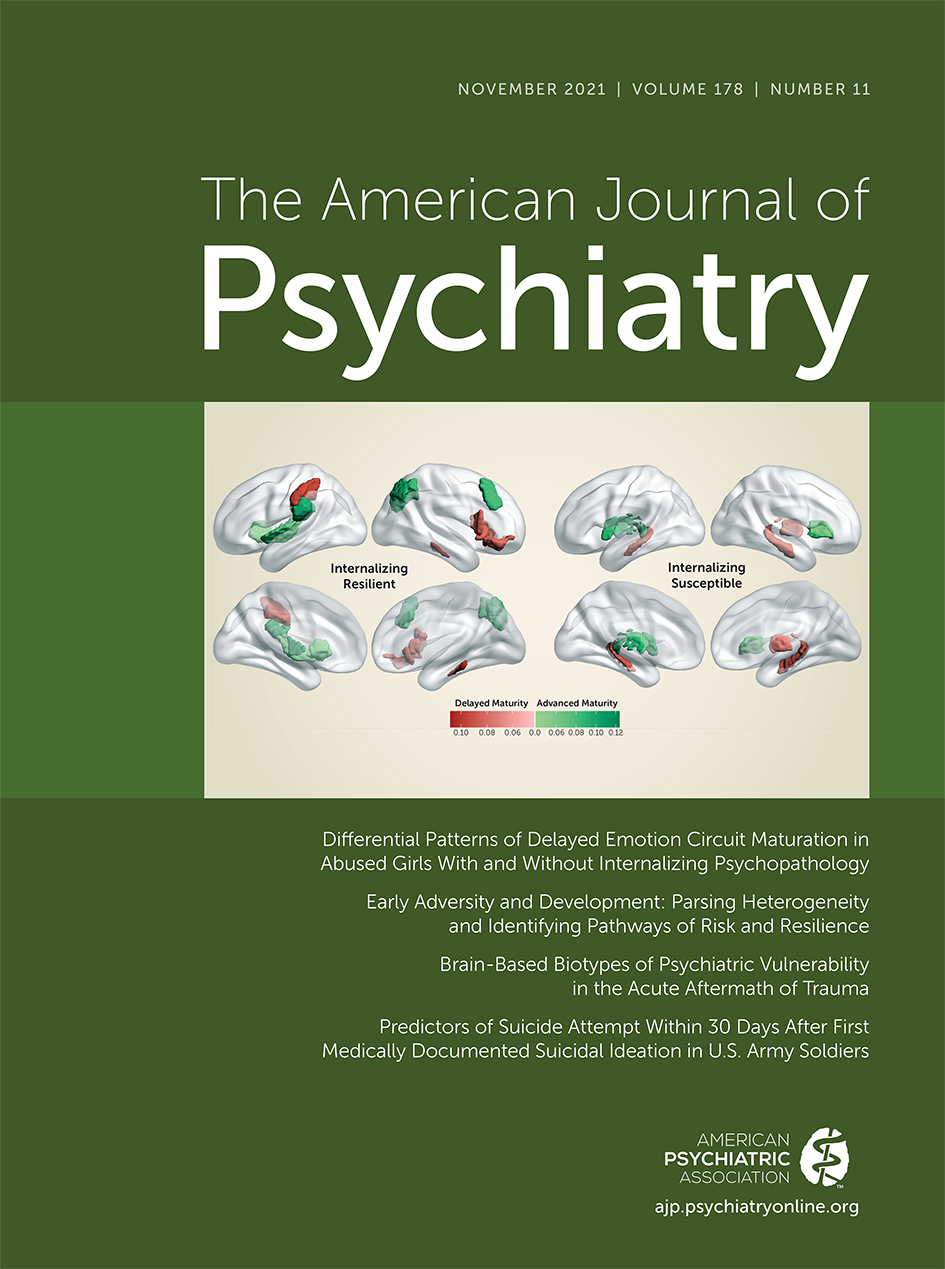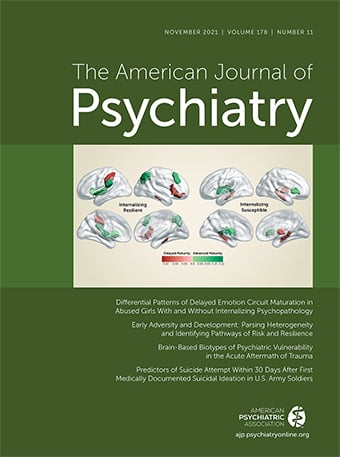In this issue, Edwards and colleagues (
1) report on a study that examines twins, siblings, and half siblings in the large Swedish national registry database to estimate the heritability of fatal and nonfatal suicidal behavior. The size of this database offers the advantage that they could examine genetic and environmental contributions to nonfatal suicide attempt and suicide death separately, and also in women and men as well as in youths and the older population. The authors found moderate heritability of both suicide attempt and suicide death, and in both men and women. The genetic load appears to be greater in women, both in youth and adulthood. By examining fatal and nonfatal suicidal behavior, Edwards et al. were able to show that there is substantial genetic overlap. From the opposite perspective, there is incomplete genetic overlap. The lack of total genetic overlap means that there may be important differences between the two types of suicidal behavior.
Edwards et al. propose that potential genetically determined differences between nonfatal and fatal suicidal behavior may make a difference in terms of risk prediction and new prevention approaches. One pressing clinical challenge has been that as many as 79% of all deaths by suicide appear to occur on the first attempt (
2). Thus, even though a previous suicide attempt is the best predictor of risk of a future suicide, detecting such a nonfatal suicide attempt history would not help prevent most suicide deaths. Because suicide is transmitted in families (
3,
4), another approach is to ask patients not only about a personal history of suicide attempt but also about a family history of suicide attempt or suicide death. Such a family history in a first- or second-degree relative can increase the risk of suicide in the proband by about sixfold. Moreover, the greater the family loading, the earlier the age at which the suicide attempt is manifested (
5,
6).
Statham et al., in a large twin study (
7), reported that there was a moderate level of heritability for suicide death, nonfatal attempts, and even suicidal ideation. Edwards et al. make the interesting point that studies combining nonfatal attempts and suicide death may detect genes common to both, and those genes may be more closely related to other clinical features shared by fatal and nonfatal suicidal behavior, namely, suicidal ideation. However, the stress-diathesis model of suicidal behavior described by Mann and Rizk (
8) suggests a more nuanced formulation.
Most suicidal behavior involves a major psychiatric disorder, and even among suicide decedents, that psychiatric disorder is untreated in more than three-quarters of cases (
9). Part of the rest of the risk is related to the diathesis, and that diathesis includes at least four major elements: 1) a propensity for more severe suicidal ideation and emotional distress or pain that behaves like a trait and may be transmitted in families and is potentially linked to transmission of suicidal behavior (
3,
10); 2) distorted social cognitions whereby negative social signals are amplified and positive social signals are blunted, as demonstrated in euthymic suicide attempters using functional MRI (
11–
14) indicating a potential trait related to suicidal behavior; 3) altered decision making that increases the likelihood that patients will choose to make a suicide attempt instead of seeking help or following through with antidepressant medication, encompassing different elements of decision making, and some are potentially traits (
15–
17); and 4) learning and problem-solving deficits that contribute to patients’ reporting that they made a suicide attempt because they could not think of any other option and felt trapped. Both learning and memory capacity are largely heritable (
18–
21). One can take the suggestion made by Edwards et al. that suicidal ideation may have a genetic basis that then spans both fatal and nonfatal suicidal behavior and extend that suggestion to all the above components of the diathesis for suicidal behavior. A major goal for future genetic studies is to obtain both larger sample sizes and, at the same time, more granular clinical and cognitive phenotyping in order to begin to quantify the heritability of these components of the diathesis.
The large Swedish database allowed Edwards et al. to examine female and male subjects separately as well as young and older age groups. The motivation was that nonfatal suicide attempt rates are higher for females and suicide death rates are higher for males. Moreover, younger individuals make more nonfatal suicide attempts relative to fatal attempts, with a ratio of about 30:1–40:1, and for older males this ratio can drop to about 6:1 (
22). Perhaps surprisingly, Edwards et al. found that the heritability of fatal or nonfatal suicide attempt is slightly higher for women compared with men. It is hard to be sure what this means, but it is important to bear in mind that all these estimates of heritability do not tell us what combinations of genes explain this heritability. The gene combinations may differ in males and females and in fatal and nonfatal suicidal behavior.
To elucidate the genes underlying the heritability of fatal compared with nonfatal suicidal behavior requires large-scale genome-wide association studies (GWASs) (
23–
25). Those data sets can then be reduced to polygenic risk scores (PRSs) in order to determine more easily how the underlying genetic architecture responsible for the heritability of suicidal behavior and suicide death are related quantitatively to traits that comprise the diathesis and to the associated major psychiatric disorders.
After years of candidate gene studies of suicide and nonfatal suicide attempts or suicidal ideation, spurred by exciting neurobiological findings in suicide decedents and in patients with more medically injurious but nonfatal suicide attempts, the lack of agreement in results, and the fear of missing the real causal genes, evolved into an approach emphasizing the unbiased GWAS method (
26). Although initial studies involved sample sizes that were far too small, we now see results of adequately powered GWASs. The latest GWAS by Mullins et al. (
25), which involved 29,782 suicide attempters (including 5,438 suicide decedents) and 519,961 control subjects, separates effects associated with fatal and nonfatal suicidal behavior. Several key observations were made in the study. The pattern of genes associated with nonfatal attempts overlapped to some degree with the pattern associated with suicide deaths, and that supports suggestions from Statham et al. (
7) and from Edwards et al. Another important finding is that there is only partial overlap with psychiatric disorders, as shown by the PRS being related to suicide even after controlling for the depression effect, even though the association is weaker. The GWAS findings do not include serotonin-related genes, but there is a signal related to inflammation and neurotrophic processes (
27–
30). Perhaps the serotonin system changes in suicide, and more lethal nonfatal suicide attempts (
31,
32) are secondary to effects of neurotrophic abnormalities (
28–
30), acquired stress response abnormalities (
33,
34), or inflammation (
27)? A final major puzzle is why the largest GWAS to date finds that the variance explained by the GWAS is less than 1%, compared with about 50% attributable to heritability (
7,
25). On the one hand, these GWAS findings indicate that each associated gene variant explains a tiny level of risk in the population; on the other hand, we have found only a small fraction of the responsible gene variants despite such a large sample study. If that is correct, then the hunt for gene variants related to suicidal behavior is only at the beginning. As we pursue this search for responsible genes, we need to remember that these genes exist because our heritability estimates prove that. We also need to remember that the possible contribution of epigenetic effects that are transmitted across generations can mimic genetic effects in being heritable.
Edwards et al. repeatedly point out the potential for suicide prevention once we can find the gene variants associated with nonfatal suicide attempts and with suicide death. It must be remembered that the base rate of the outcome one seeks to predict is crucial in determining how good a predictor needs to be in order for it to be effective. Details can be found in a seminal paper by Jacob Cohen (
35). A super genetic predictor with 90% sensitivity and 90% specificity, when applied to a population with a 1% suicide rate (which is higher than in most clinical populations), would have a predictive rate of 8% and a false positive rate of 92%. Thus, out of such a population of 10,000 people, it would identify 1,080 predicted suicides, and, of those, 990 would be false positives. That is a huge number to be treated in error as being at imminent risk of suicide.
In order to improve the performance of our predictor, we need to raise the base rate of the suicide death outcome that we seek to predict and prevent. We can do that in two ways. First narrow the search clinically to only much higher-risk individuals, and then narrow the search temporally to periods of higher risk for those individuals. We can do that partly with a clinical screen. Suicide death is rare in the general population (13/100,000 per year), but it becomes 2–50 times more common in those with a psychiatric disorder, and six times more common in those with a first- or second-degree relative with suicidal behavior. Finally, the risk jumps 30- to 40-fold in those who survive a suicide attempt.
Temporally we know that 80% of those who die by suicide after a nonfatal suicide attempt die within 12 months of that attempt (
36). We should focus on that first 12 months after an attempt. We can further improve the chances of detection by focusing on other higher-risk periods, such as discharge from hospital or the emergency department of patients reporting more severe suicidal ideation that includes a plan or intent to act. Since we are trying to predict risk in those with a psychiatric disorder, we still need to be able to detect risk without a history of a prior suicide attempt, because most suicide decedents die on the first try. The hope from genetic studies is to develop a panel of risk predictor gene variants with enough positive predictive power in these clinical populations during these higher-risk periods. Since gene expression profiles are the product of both genetic variants and epigenetic modifications, both will need to be employed to optimize a genomic risk score for patients. Epigenetic changes are a pathway for onset of major depression and development of pronounced aggressive/impulsive traits that mediate the relationship between childhood adversity and risk of suicidal behavior in adults. Gene expression profiles have been generated from white blood cells and from expression studies in the brain of suicide decedents, and studies have implicated inflammation and trophic pathways (
27,
37–
42).
The realization that about half the risk of suicide death or nonfatal suicide attempt is heritable should not evoke a sense that these outcomes are inevitable and that prevention is futile. We know that major depression can be effectively treated and the risk of suicide thereby substantially diminished. Means restriction, such as reducing firearm access, can mean that many who seek to die by suicide may abandon their attempt or use a less lethal method with a much better chance of survival (
43). Thus, in searching for the genomic risk predictors of suicidal behavior, we not only seek to improve detection of higher-risk patients, but we may also identify modifiable risk factors.

